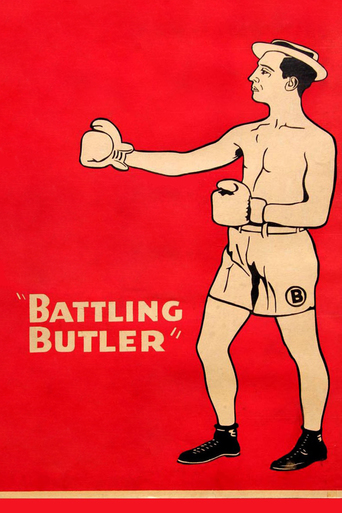ccthemovieman-1
The first 30 minutes of this Buster Keaton film are some of the stupidest he ever made, at least from what I've seen. I don't blame him; this is the film world where even since this period - around 1920 - marriage is always trivialized and people are always lying. Why was that so frequent in classic movies, in particular? It's disgusting. Here Alfred "Battling" Butler, a spoiled rich young man - in order to keep his girl - lies about being the lightweight boxing champion of the world, because that guy, who has the same name as him, is a hero and he wants to impress her and her big brother and big father. He wants to marry her right away because she's pretty and she consents as soon as she hears he's a big shot. Boy, those are great reasons for marriage!After the quickie marriage, Buster heads off for training camp for his supposed title defense against the "Alabama Murderer." Later, the real "Battling Butler," to do the impostor a favor and save his marriage, lets him be the real thing and fight while he retires.The training - and the first real laugh of the film - isn't until 47-minute mark when Buster begins training and can't get over the ropes. He is helpless outside and inside the ring as it turns out.The training escalates as Buster begins roadwork the next day.....but he isn't up to training or fighting or any of this. Fortunately, a big twist occurs late in the movie which saves Buster from going into the ring, although the little man does save his honor after he fights the real "Battling Butler."I would agree with the critics on this one: it's far from Buster's best work.
Polaris_DiB
This is kind of a typical Buster Keaton story, except in reverse: the girl comes along earlier in the movie, the men are impressed with him earlier on, everything works out for him earlier on, and then the rest of the movie is him trying to maintain his luck versus trying to get the girl against all the forces of bad luck. It also goes in a couple surprising directions, which are noteworthy.I notice through the evolution of Keaton's movies that he did more and more acting and less and less physical comedy, with the exception of course of The Saphead, which was his first feature-length that was mostly drama-based, not slapstick-based. By now, 1926, Keaton knows what he's doing and knows where he's going, and thus this is a pretty clean and well-put together movie.Still, the stuff he does in the training-ring scene is amazingly original and marvelous. When watching this movie, one expects something more along the lines of Chaplin's moment in City Lights, where he dodges around limberly and almost succeeds. Not the case, this was more real and brutal. Marvelous stuff, really, and surprising in its own right.--PolarisDiB
H_A_Wellington_IV
Battling Butler (1926) was a funny film by comedian/director BusterKeaton. This is one of his lesser known films that he made before theclassic The General. Keaton plays a soft "mama's boy". His father decides that his son needs to toughen up. So he does everything he can to make aman out of his son. Meanwhile, Buster finds true romance with a nice girl. Can Keaton become a man and win the girl or will he always be a weakling?A fun film from Buster Keaton. The usual stunts and prat falls are in thispicture. Old stone face can take an average storyline and breath some lifeinto it. The direction is executed very well and the film has a very quaintending. Not a classic by any means, just an entertaining film.Recommended for Buster Keaton fans.B+
frankgaipa
This relatively slight Keaton effort includes some intricate identity switching, but let me describe instead one superb bit of choreography.
Near the end of the riverside idyll, rich pansy Keaton's met farmer's daughter Sally O'Neil, they've fallen for each other, and been discovered by her father and brother. After a brief unhappy confrontation, the father and brother disappear through a clump of trees to the left. Night comes, and Keaton walks O'Neil home through the same clump of trees. Arriving, they turn and face each other, somewhat at ease now, from opposite sides of the gate. The father and brother, seeming even larger than they are because they enter from nearer the camera, come storming from the right, pass between the couple, through the gate, and up some steps into the house. The couple look away from us to the house, then at each other. Keaton begins to take his leave, and they both look slightly right, roughly toward us, at the route he will take. He starts off, but takes fright of the trees. She sees, catches up and walks him home, then walks back. The to and fro, the coming and going, of all this is delightful. It's delightfully timed and executed. (If you pay closer attention than you're supposed to, you'll realize it's a smallish set, the forest is a tree or two, and Keaton's tent maybe 50 strides from the house, probably in full view of it.)Great shot later: Keaton clad only in boxing shorts, shoes, and top hat, bare-chested, walking O'Neil through an authentic-looking evening-dressed crowd along a real-looking downtown street.



